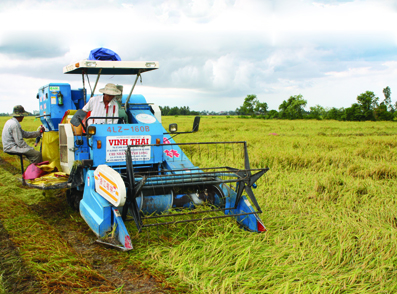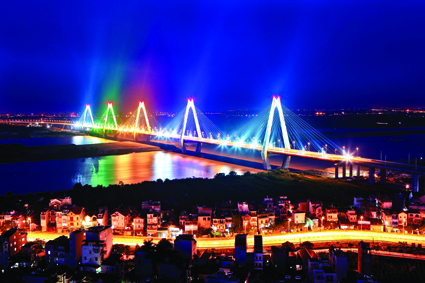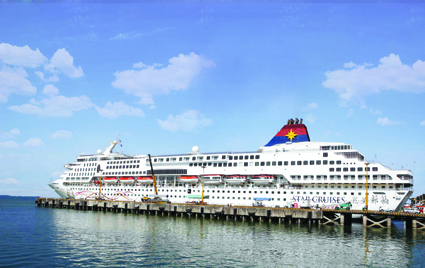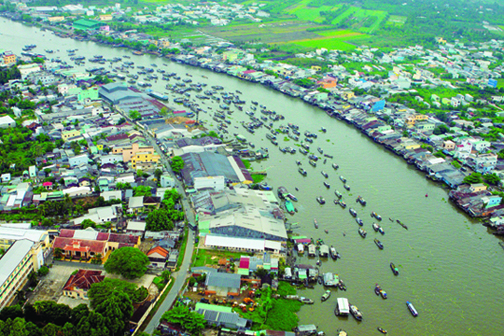Located 60 kilometers to the east of Hanoi and in the center of the northern key economic region, Hai Duong, a Red River delta province, borders six provinces: Bac Ninh, Bac Giang and Quang Ninh in the north, Hung Yen in the west, Hai Phong in the east and Thai Binh in the south. It is the 11th most populous locality in the country with nearly 2 million people. It has a provincial city with the same name, Chi Linh town and 10 districts (Nam Sach, Kinh Mon, Kim Thanh, Thanh Ha, Ninh Giang, Gia Loc, Tu Ky, Thanh Mien, Cam Giang and Binh Giang).
 |
| Farmers harvest litchi fruits in Thanh Ha district, Hai Duong province__Tran Viet/VNA |
Foreign investment attraction
As part of the northern key economic triangle connected to other regions with artery traffic routes like National Highways 5, 18, 37 and 38A and Hanoi-Hai Phong railway, Hai Duong province has great potential and competitive edge to form industrial parks (IPs).
From only three industrial parks approved in 2003, Hai Duong has to date ten IPs covering a total area of around 2,000 hectares. Under its IP development master plan through 2015 with 2020 vision recently approved by the Prime Minister, the province will have a total of 18 IPs occupying 3.500 hectares.
The provincial authorities regard the attraction of new investment projects as one of the important tasks to promote its socio-economic development.
According to the Foreign Investment Agency under the Ministry of Planning and Investment, by mid December 2014, Hai Duong ranked 11th among 63 provinces and cities nationwide in foreign direct investment (FDI) attraction with 321 valid projects capitalized at USD 6.48 billion.
With an average FDI capital per project of USD 20.2 million, the size of FDI projects in the province is higher than the national average (USD 14.3 million).
The processing and manufacturing sectors have attracted the largest share of FDI with 270 projects with a combined registered capital of USD 3.57 billion, representing 55.2 percent of the province’s total registered FDI capital. Those sectors are followed by electricity, gas and water supply and air-conditioning system manufacture.
At present, 25 countries and territories have been investing in the province. Hong Kong ranks first with a registered investment of USD 2.88 billion in over 30 projects. Japan ranks second, followed by Taiwan and the Republic of Korea.
As reported by the provincial Investment and Planning Department, in 2014 alone the Hai Duong IP Management Board granted investment certificates to 36 new FDI projects capitalized at USD 395 million in garment and textiles, footwear and electronic part assembly. Of the total, 17 projects worth some USD 72 million are located outside IPs and 18 projects totaling USD 323 million are implemented in IPs. The USD 225 million Dai An Vietnam-Canada International Hospital project is the most capitalized project, accounting for 57.2 percent of the province’s total new FDI inflow. Meanwhile, the Republic of Korea ranks first in terms of the number of projects.
Also in 2014, foreign-invested enterprises (FIEs) posted revenues of USD 3.7 billion, making a year-on-year rise of 8.3 percent. FIEs also contributed around USD 2.8 billion to the province’s total export turnover and generated jobs for 18,000 local workers.
These results are attributable to Hai Duong’s efforts to reform administrative procedures relating to the assessment of environmental impacts, construction permits and land allocation to shorten waiting time and cut unnecessary costs for investors.
As reported by the Hai Duong IP Management Board, it has set up hotlines to settle difficulties faced by investors and timely handle enterprises’ environmental violations.
Local authorities have actively supervised and inspected investment projects and provided investors with support to deal with emerging difficulties to put their projects into operation as scheduled.
Hai Duong expects to attract USD 200 million in FDI this year, focusing on high-quality, hi-tech and environment-friendly projects on manufacturing, mechanical engineering and allied industries and biotechnology from Japan, the Republic of Korea, European nations and the U.S. It also encourages foreign investors to build such socio-economic infrastructure facilities as roads, power grids, water supply systems, hospitals, schools, and entertainment centers.
To attract more investors, in addition to the Government-provided investment incentives, investors in Hai Duong IPs would be exempted from land rental for 10 years and enjoy a 50-percent reduction of land rental for the subsequent 10 years. In addition, investors would receive financial assistance from the provincial budget equivalent to the corporate income tax amount payable for two years after earning first taxable income and 50 percent for the subsequent year.
In the coming time, the provincial People’s Committee will host dialogues with investors every six months to promptly tackle their problems. It will publicize procedures for grant of investment certificates on local websites with a view to facilitating foreign investment.
Socio-economic development
IPs have made important contributions to attracting investment, boosting exports, increasing state budget revenues, generating employment, accelerating economic restructuring, and improving product competitiveness.
According to a report on the implementation of the 2014 socio-economic development plan and plan for 2015 revealed by the provincial People’s Committee, in 2014, the provincial gross domestic product (GDP) recorded a year-on-year rise of 7.7 percent. The total retail sales and service revenues were expected to reach VND 34.3 trillion, posting a growth rate of 11.4 percent. Export turnover was estimated to grow 15.7 percent to reach USD 4.18 billion.
The province earned an agriculture-forestry-fisheries value of VND 16.1 trillion, 3.1 percent higher than the last year’s figure; and an industrial production value of over VND 99 trillion, posting an increase of 12.7 percent. Despite facing difficulties and challenges, the province’s economic sectors created 33,552 new jobs.
The province has lowered the poverty rate to 4.62 percent from 5.82 percent and raised its per-capita GDP to VND 39 million. In 2014, it received some 2.8 million tourists, including 215,000 foreigners, and earned a total VND 1.2 trillion from tourism.
This year, Hai Duong strives to record a GDP growth rate of at least 7.5 percent with agriculture, forestry and fisheries accounting for 15.6 percent; industry and construction representing 52.3 percent, and services making up 32.1 percent, of the province’s economic growth value. It targets a per-capita GDP of VND 44.2 million and a 10-percent growth in export revenues. The province plans to reduce its poverty rate by one percent and malnourished under-five children to 12 percent and generate 320,000 new jobs for local workers.
Tourism potential
Covering an area of 1,662 square kilometers, Hai Duong is home to 2,382 hectares of natural forests and 6,756 hectares of planted forests. Its famous Dao Co (Stork Island) in Thanh Mien district attracts thousands of storks, herons and birds to feed and lay eggs in winter and spring and has recently become an attractive eco-tourism destination of the province and the Red River delta, suitable for field trips of students and researchers.
Travel operators have planned to establish a new tour in the area, including visits to the Stork Island, Hong Phong water puppetry village, Ninh Giang village of banh gai (glutinous rice cake blackened in a concoction of edible leaves), and the temple of Khuc Thua Du (an uprising leader against Tang dynasty’s rule in the 9th century). Another one- or two-day tour to Dong Ngo 1 and Minh Khanh temples, Thanh Hai water puppetry village and Thanh Ha litchi village will also be opened.
At present, the province has 150 tourist accommodations facilities with over 3,000 rooms, 15 travel agents, 15 tourist transportation businesses.
In 2015, the province expects to welcome 1.15 million visitors, including 250,000 foreign holiday makers, and achieve a total tourism revenue of more than VND 1.6 trillion. To achieve these targets, the province will improve mechanisms and policies to promote eco-tourism, efficiently use investment capital, develop human resources to meet tourism development requirements and enter into domestic and international tourism development cooperation.
Director of the Hai Duong Tourism Information and Promotion Center Khong Quoc Tuan said Hai Duong is calling for qualified investors at home and abroad to study, survey and formulate projects in line with the provincial master plan on tourism development through 2020, with a vision towards 2030, and promises to offer the most favorable conditions to investors.
In the near future, the province will call for investment in building a tourist resort in the Con Son mountain area to attract tourists from Japan and other ASEAN member nations, and the Vietnamese Village Tourist resort to feature cultural values of Vietnamese ancient villages to serve domestic and foreign visitors. Hai Duong will also build a modern entertainment-tourism complex to serve locals and tourists from neighboring regions as well.
To attract investment in tourism programs and tourism resort projects, the province will update interested investors on relevant mechanisms and policies, and facilitate their enjoyment of incentives in income tax, land use tax and import duty on machinery, equipment and raw materials and other incentives provided in the investment law and relevant laws.- (VLLF)





